Table of contents
What is Edge Delivery?
Benefits of Edge Delivery
Edge Delivery Services With Adobe Experience Manager (AEM):
Real-life Example
Steps Related to Leveraging Decoupled Architecture in Edge Delivery
Conclusion
Edge delivery's rapid rise is transforming the way we interact with websites and apps and consume content. Edge delivery lowers latency and boosts performance by carefully locating servers and content delivery networks (CDNs) closer to end users. The internet experience is being revolutionized by this, becoming quicker, more responsive, and mEdge Delivery: The Facade of the Conventional Online Shopping Experiencing engaging. We'll look at the main ways edge delivery is improving our interactions with the online world and changing the digital landscape in this piece. Prepare yourself for the internet of the future.
What is Edge Delivery?
One of the most vital aspects of a Content Delivery Network (CDN) is edge delivery. Edge delivery caches content on servers situated at the network’s edge near a major population center so it gets closer to end users. In this way, there is less latency and better performance because data travels short distances.
Additionally, edge delivery frees up traffic from origin servers so they can handle additional requests. A CDN enables the rapid and effective delivery of material to users worldwide by arranging edge servers in strategic places. This is essential for delivering dependable, quick experiences for data-intensive apps like eCommerce, gaming, and streaming media.
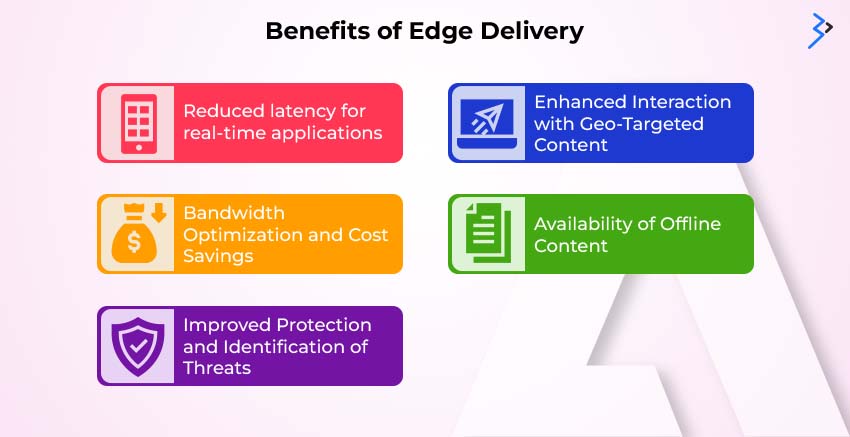
Benefits of Edge Delivery
A number of advantages can be obtained by integrating edge delivery with your content management system (CMS), which will improve your content distribution plan. Among its advantages are the following ones:
Reduced latency for real-time applications
Edge delivery has capability to decrease latency for applications where time is an important factor. Edge delivery guarantees that your material is served from the closest accessible location by caching it on servers close to your users. The above application is particularly useful for real-time apps that may be affected by slight delays, which makes it important in online gaming, live streaming, and interactive web applications.
Enhanced Interaction with Geo-Targeted Content
In the area of geo-targeting content delivery, edge computing stands out by ensuring customers get information that relates to their specific location. Because it empowers them to customize the user experience for multiple countries and language communities, it is a win-win for businesses with clients scattered worldwide. The local edge will serve content to users, achieving lower latency and better user experience for an improved level of engagement and loyalty.
Bandwidth Optimization and Cost Savings
Additionally, you may minimize your bandwidth utilization and lower content delivery costs by utilizing Adobe Experience Manager (AEM) edge delivery. You can lessen the strain on your origin servers by caching frequently visited material at the edge. This will free up bandwidth for other applications and lessen the need for increased expensive bandwidth. This is especially helpful for companies using Adobe Experience Manager (AEM) Edge Delivery Services which often have high traffic on their websites or deliver large media files like images or videos.
Availability of Offline Content
Edge delivery can make sure that users can still access your content in the case of a server or network failure. You can give consumers a backup plan by caching important content on edge servers, guaranteeing that they can still access vital data in the event that the primary server goes down. For companies whose mission-critical activities depend on their web presence, this capability is extremely beneficial.
Improved Protection and Identification of Threats
By providing an additional security layer against online attacks, edge delivery can improve the security of your content management. Edge delivery helps to mitigate the consequences of threats like DDoS attacks and malicious traffic by recognizing and filtering traffic at the edge, protecting your website from disruptions. Furthermore, combining edge delivery with a Composable Architecture helps strengthen security protocols and protect your CMS from ever changing cyberattacks.
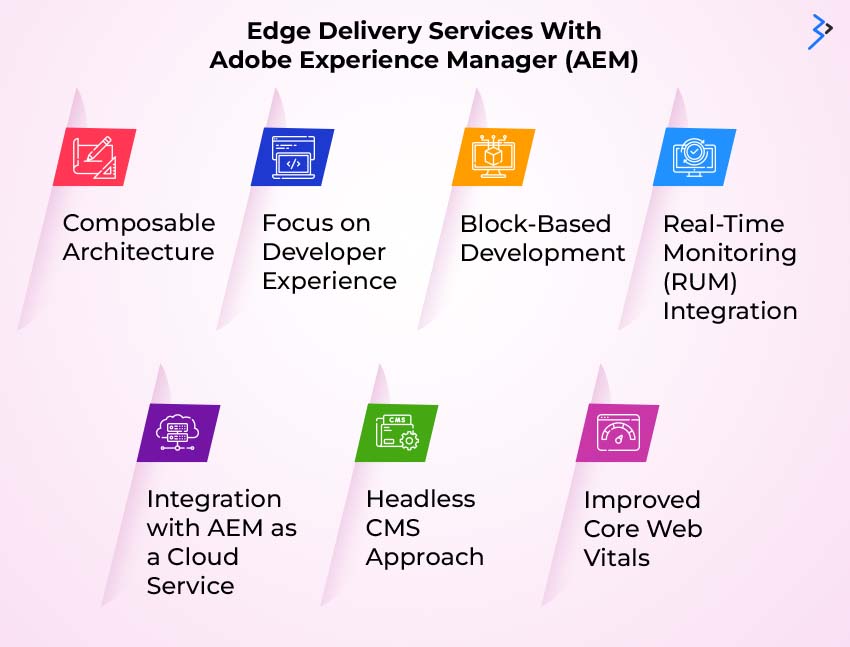
Edge Delivery Services With Adobe Experience Manager (AEM):
Delivering and managing digital experiences has never been easier thanks to Adobe Experience Manager (AEM)'s essential component, Edge Delivery Services. Offering a multitude of features and capabilities, this cutting-edge service improves the effectiveness, performance, and adaptability of content distribution. Let us explore the essential ideas and features of Edge Delivery Services utilizing AEM.
Core Concept of AEM Edge Delivery
AEM Edge Delivery aims to deliver exceptional digital experiences, enhancing engagement and conversions. It uses Edge Delivery Services to expedite authoring and development, enabling quick content updates and distribution. Content deployment times have significantly decreased in 80% of enterprises using AEM Edge Delivery, with some reporting a 50% reduction. This is largely due to the Decouple Architecture method, simplifying content creation and management.
Composable Architecture
The composable design of Edge Delivery Services offers a great deal of flexibility in content authoring. In addition to document-based authoring, authors can make use of AEM content management and AEM-based authoring via the Universal Editor. This architecture makes it possible to publish information instantly without having to rebuild it and to update it seamlessly in a variety of formats, including Microsoft Word.
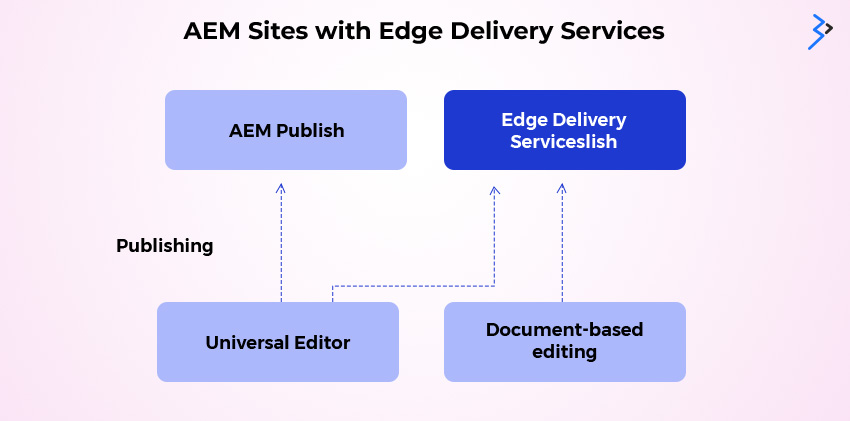
Focus on Developer Experience
AEM Edge Delivery Services' emphasis on improving the developer experience is one of its main selling points. By separating content sources and providing several authoring options, such as document-based authoring and AEM-based authoring, the service streamlines the authoring process. This method improves authorship productivity while streamlining the publication and content generation processes.
Block-Based Development
The core idea of Edge Delivery Services is blocks; it offers a library of pre-made blocks that may be expanded to suit the particular requirements of a project. With the help of this block-based development methodology, developers can produce and manage content in an organized and effective manner, guaranteeing scalability and consistency across various digital experiences.
Real-Time Monitoring (RUM) Integration
Through integration with Real User Monitoring (RUM) solutions, enterprises can examine performance indicators and website usage. Utilizing RUM's capabilities helps organizations efficiently enhance their digital properties by offering insightful information about user behavior, site performance, and overall user experience.
Furthermore, combining A/B testing with RUM can boost user preference and behavior analysis even more, enabling businesses to make data-driven decisions that will improve their digital experiences and yield greater outcomes.
Integration with AEM as a Cloud Service
The Edge Delivery Services from Adobe Experience Cloud work with AEM as a cloud service, offering a stable framework for organizing and distributing digital information. This improves performance, scalability, and dependability, enabling businesses to produce and distribute captivating content more effectively. Businesses can build individualized, consistent user experiences across multiple channels and devices by utilizing Edge Delivery Services within Adobe Experience Cloud. Advanced features and capabilities that propel digital transformation and business success are unlocked by this combination.
Headless CMS Approach
Content can be managed and provided separately from the display layer thanks to Edge Delivery Services' support for a headless CMS strategy. Organizations can now distribute content across multiple channels and devices while maintaining a consistent and customized user experience thanks to the decoupling of content and presentation.
Improved Core Web Vitals
The integration of Edge Delivery Services and Adobe Experience Platform (AEP) improves key Web Vitals like loading speed, interactivity, and visual stability, hence elevating digital experiences. Better engagement and conversion rates are generated, search engine rankings are raised, and the user experience is improved.
While Edge Delivery Services guarantees quick and effective content delivery, AEP handles content across channels. Businesses can create dynamic, high-performing digital experiences that connect with audiences and produce significant outcomes by integrating these platforms.
Real-life Example
Qwilt, a vendor of the newest computing solutions, is using edge delivery to enhance content delivery. The Open Edge Cloud solution has enabled content providers to offer first-rate contents to users at the edge of the network by reducing latency and improving user experience. This strategy helps monetize Qwilt’s edge-content-delivery products through personalized adverts, device-specific customized content and quicker access that also attracts more users and viewers.
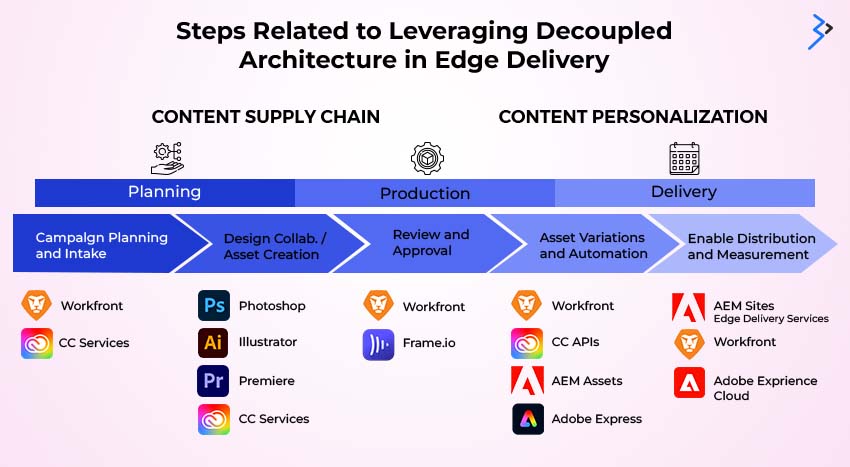
Steps Related to Leveraging Decoupled Architecture in Edge Delivery
AEM’s decoupled architecture for edge delivery which enhances user experience and optimizes content delivery is one of its key advantages. The following are the major steps in AEM’s edge delivery process:
Content Creation
Authors and designers use the AEM authoring environment to create and manage content at the start of the content production process. Making pages, assets, and other content components that will be accessed by end users falls under this category. In order to expedite the process of creating content and guarantee that it is correct, current, and compliant with brand standards, AEM offers an intuitive user interface along with strong tools.
Content Delivery Network
Following the development and approval process, AEM employs a Content Delivery Network to distribute content across multiple edge servers globally. To reduce latency and boost performance, a content delivery network (CDN) is a web-based group of computers that delivers from the nearest edge to the user. Regardless of where consumers are, they will always get their content promptly and efficiently via AEM's smooth collaboration with renowned CDNs.
Content Delivery
Edge computing connected websites and applications channel user content in order to fasten the process. If caching occurs, the content gets delivered straightly, from which server load is unburdened and response time is expedited. If the cached material is not fully filled, the request heads to the origin server, again the AEM case, that produces and caches the content.
Real-Time Updates
The capacity of AEM's edge delivery to manage real-time content updates is one of its main features. Users will always view the most recent material since updates made to content in the AEM authoring environment are automatically propagated to the CDN. This is especially crucial for content that needs to be consumed quickly, including news stories, product specifications, or event specifics.
Personalization
Personalization is supported by AEM's edge delivery, which enables businesses to provide customized content to specific users based on their interests, actions, or other characteristics. AEM can carry out real-time customization calculations and rapidly and effectively provide users with personalized content by utilizing the edge servers of the CDN.
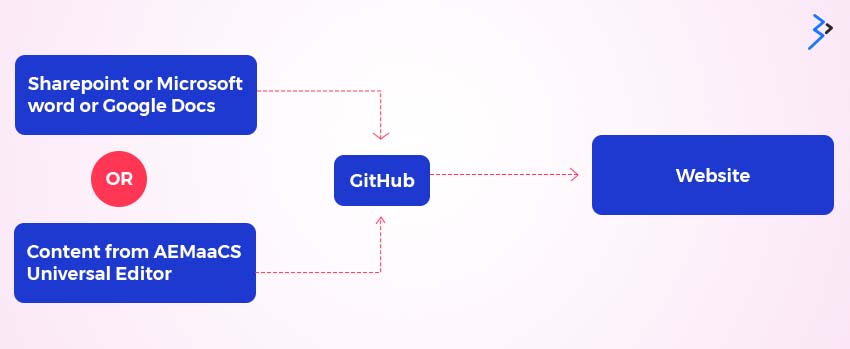
Conclusion
Edge delivery, which offers quicker, more secure, and customized interactions, is completely changing how people engage with websites. Edge delivery will become increasingly important in determining how people interact online in the future as the digital landscape develops. The opportunities for edge delivery are boundless, with open-source innovation being driven by sites like GitHub. To stay ahead of the curve and provide great online experiences, companies and developers must leverage the power of edge delivery going forward.
FAQs:
Does AEM Edge Delivery replace AEM as a CMS?
No, as a CMS, AEM Edge Delivery does not take the place of AEM. By improving content delivery and performance at the edge and putting an emphasis on speed and scalability without taking away from the essential CMS features, it enhances AEM.
Can AEM Edge Delivery handle dynamic content updates?
Yes, dynamic content updates can be handled effectively by AEM Edge Delivery. By automatically storing and serving dynamic content updates, it guarantees real-time content delivery while preserving responsiveness and guaranteeing users receive the most recent information.
Can I use any front-end framework with AEM Edge Delivery?
It is true that AEM Edge Delivery works with a number of front-end frameworks. It gives developers the freedom to utilize the front-end frameworks of their choice, facilitating seamless integration and modification to satisfy certain functional and design requirements.
How does AEM Edge Delivery improve website loading times?
By caching and delivering material closer to end users at the edge servers, AEM Edge Delivery improves website loading speeds. It reduces latency, increases responsiveness, and enhances performance thereby making sure that it has faster loading time in order for this website experience to be smooth.
How does Adobe Experience Platform integrate with AEM Edge Delivery customization?
By linking to Adobe Experience Platform (AEP), AEM Edge Delivery can deliver personalized content based on user profiles. Through the integration of AEP's customization features with AEM Edge Delivery's edge capabilities, companies can provide users with content that is customized according to their individual preferences and behavior.
Can AEM Edge Delivery handle A/B testing for content variations?
Absolutely, AEM Edge Delivery allows for A/B testing of different content versions. Organizations might want to test different versions of their contents, layouts or styles that will enhance how users engage with them leading to more conversion rates. Now digital experiences are being effective as decisions may now be data-driven because of this feature.
Related Articles
Digital Transformation
Adobe Experience Manager (AEM): The Ultimate Guide for Enterprises

